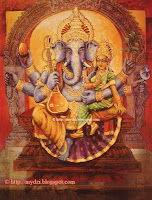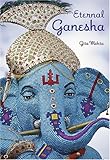All of us know that Ganesha has elephant head with only one tusk, fat and has big belly, his mount is rat (mooshika) and many more. Have you ever think what is the meaning of the these symbols? Many of us don't know what is the meaning of all this things. So Lets see the pictures below

Ganesha Symbolism
Big Head: - Think Big
Large Ears: - Listen More
Small eyes: - Concentrate
Small Mouth: - Talk Less
Trunk: - high efficiency and adaptability
Large Stomach – Peacefully digest all good and bad in life.
One tusk: - retain good throw away bad
Sweets or Modaka: - rewards of Sadhana , a symbol of what He loves most, moksha, liberation, the sweetest of all things sweet.
Blessing: - Bless and protects on spiritual path to supreme
Axe: - To cut off all bonds of attachment
Rope: - To pull you nearer to the highest goal
Prasad: - The whole world is at your feet and for your asking
Mouse: - Desire, unless under control can cause havoc you ride the desire and keep it under control and don’t allow it to take you for a ride. The mouse has a keen sense of smell. The mouse also symbolizes the darkness of night. The mouse can see well in the dark. As Vinayaka's vehicle the mouse signifies an object that leads man from darkness to light. Picture above Ganesha Symbolism Source Angel Fire
GANESHA Battle With ParshuRam

Ganesha said to have lost his one tusk in a fight with Parashuram
9 Ganesha form out of 32 Ganesha









Recommend Books On Ganesha





6 comments:
Thank you for the informative post!
do you know what 2 entwined snakes would be in nepalese ganesha
Lord Ganesha is also called Vinayak ( knowledgeable ) or Vighneshwer (god to remove obstacles). He is worshipped, or at least remembered, in the beginning of any auspicious performance for blessings and auspiciousness.
Ganesha Photo, Lord Ganesha Photo, Sri Ganesh Wallpaper
As I am also little interest in this very matter, I found this post very informative and interesting. Thanks for sharing.
Nice blog to look forward to...
Thanks for all friend,
I appreciate your Words in this blog.
Dilip dai and Chanting Buddha Welcome to this blog. Nice to see you here.
Post a Comment